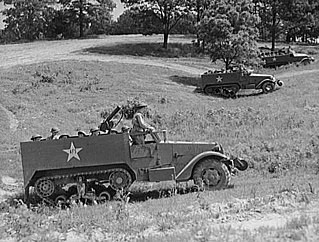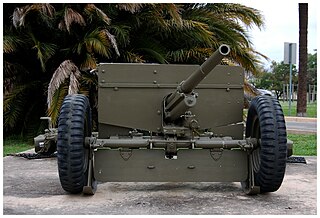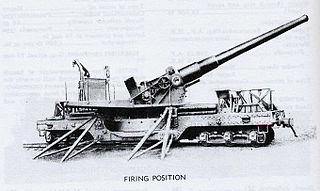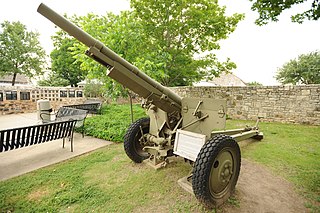
The M3 Stuart/Light Tank M3, was an American light tank of World War II. An improved version of the tank entered service as the M5 in 1942 to be supplied to British and other Commonwealth forces under lend-lease prior to the entry of the U.S. into the war. Afterwards, it was used by U.S. and Allied forces until the end of the war.

The 90 mm gun M1/M2/M3 was an American heavy anti-aircraft and anti-tank gun, playing a role similar to the German 8.8cm Flak 18. It had a 3.5 in (90 mm) diameter bore, and a 50 caliber barrel, giving it a length of 15 ft (4.6 m). It was capable of firing a 3.5 in × 23.6 in shell 62,474 ft (19,042 m) horizontally, or a maximum altitude of 43,500 ft (13,300 m).

The M3 half-track was an American armored personnel carrier half-track widely used by the Allies during World War II and in the Cold War. Derived from the M2 half-track car, the M3 was extensively produced, with about 15,000 standard M3s and more than 38,000 variant units manufactured.

The M115 203 mm howitzer, also known as the M115 8-inch Howitzer, and originally the M1 8-inch Howitzer was a towed heavy howitzer developed by the United States Army and used during World War II, the Korean War, and the Vietnam War. Post-WWII it was also adopted by a number of other nations in Europe, the Middle East, and Asia.

The M101A1 howitzer is an artillery piece developed and used by the United States. It was the standard U.S. light field howitzer in World War II and saw action in both the European and Pacific theaters and during the Korean War. Entering production in 1941, it quickly gained a reputation for accuracy and a powerful punch. The M101A1 fires 105 mm high explosive (HE) semi-fixed ammunition and has a range of 12,330 yards (11,270 m), making it suitable for supporting infantry.

The 37 mm gun M3 is the first dedicated anti-tank gun fielded by United States forces in numbers. Introduced in 1940, it became the standard anti-tank gun of the U.S. infantry with its size enabling it to be pulled by a jeep. However, the continuing improvement of German tanks quickly rendered the 37 mm ineffective and, by 1943, it was being gradually replaced in the European and Mediterranean theaters by the more powerful British-developed 57 mm gun M1. In the Pacific, where the Japanese tank threat was less significant, the M3 remained in service until the end of the war, but some 57mm guns were issued.

The 3-inch gun M1918 was a United States 3-inch anti-aircraft gun that entered service in 1918 and served until it was largely superseded by the 3-inch anti-aircraft gun M3 in 1930, though the M1918 remained with some National Guard units until early in World War II. The M3 was subsequently replaced by the M1 90mm AA gun early in World War II, primarily during 1942. The M3 3" gun was later adapted for the anti-tank role, serving as the main armament of the M10 tank destroyer during World War II.

The 76 mm gun M1 was an American World War II–era tank gun developed by the U.S United States Ordnance Department in 1942 to supplement the 75 mm gun on the basic Medium tank M4. It was also used to arm the M18 Hellcat tank destroyer.

The 75 mm Howitzer Motor Carriage M8 was a self-propelled howitzer vehicle of the United States in use during World War II. It was developed on the chassis of the M5 Stuart tank and was equipped with a M116 howitzer in an M7 mount.

The 105 mm Howitzer M3 was a U.S. light howitzer designed for use by airborne troops. The gun utilized the barrel of the 105 mm Howitzer M2, shortened and fitted to a slightly modified split trail carriage of the 75 mm pack howitzer.

The 155 mm gun M1 was a 155 millimeter caliber field gun developed and used by the United States military. Nicknamed "Long Tom", it was produced in M1 and M2 variants, later known as the M59. Developed to replace the Canon de 155mm GPF, the gun was deployed as a heavy field weapon during World War II and the Korean War, and also classed as secondary armament for seacoast defense. The gun could fire a 100 lb (45 kg) shell to a maximum range of 14 mi (23 km), with an estimated accuracy life of 1,500 rounds.

The 3-inch gun M5 was an anti-tank gun developed in the United States during World War II. The gun combined a 3-inch (76.2 mm) barrel of the anti-aircraft gun T9 and elements of the 105 mm howitzer M2. The M5 was issued exclusively to the US Army tank destroyer battalions starting in 1943. It saw combat in the Italian Campaign and on the Western Front in Northwest Europe.

The 240 mm howitzer M1, popularly nicknamed the "Black Dragon", was a towed howitzer used by the United States Army. The 240 mm M1 was designed to replace the World War I era 240 mm howitzer M1918, which was based on a 1911 French design and was outdated by World War II.

The 4.5 inch gun M1 was a field gun developed in the United States in the beginning of World War II. It shared the same carriage with the 155mm Howitzer M1 and fired the same ammunition as the British BL 4.5 inch Medium Field Gun. Beginning in 1944, the weapon was used by the U.S. Army as corps-level artillery; with the end of hostilities, it was declared obsolete.

The 8-inch Navy gun Mk.VI M3A2 on railway mount M1A1 was a World War II improved replacement for the World War I-era 8-inch M1888 gun and was used by the US Army's Coast Artillery Corps in US harbor defenses. The guns were also mounted in fixed emplacements on the barbette carriage M1A1. These guns were US Navy surplus 8"/45 caliber guns from battleships scrapped under the 1922 Washington Naval Treaty. Mark VI was the Navy designation. The Army designation for this gun was "8-inch Navy gun Mk.VI M3A2".

The T30 Howitzer Motor Carriage (HMC) was a United States Army self-propelled gun used in World War II. Its design was based on requirements for an assault gun issued by the Armored Force in 1941 and it was built as an interim solution until a fully tracked design was complete.

The T19 Howitzer Motor Carriage (HMC) was a 105 mm (4.1 in) howitzer mounted on a M3 Half-track chassis. It saw service during World War II with the U.S. Army. Its secondary armament consisted of an air-cooled .50 in (13 mm) M2 machine gun for local defense. It was produced by Diamond T between January 1942 and April 1942.

The 75 mm Field Gun M1897 on M2 Carriage was a field gun and anti-tank gun which was used by the US Army during the interwar period and World War II.































